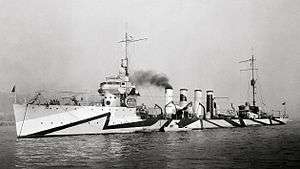USS Henley (DD-39)
 USS Henley (DD-39), port bow, camouflaged, 1918 at Queenstown, Ireland. | |
| History | |
|---|---|
| Name: | Henley |
| Namesake: | Captain Robert Henley, awarded Congressional Gold Medal |
| Builder: | Fore River Shipbuilding Company, Quincy, Massachusetts |
| Cost: | $667,235.52[1] |
| Laid down: | 17 July 1911 |
| Launched: | 3 April 1912 |
| Sponsored by: | Miss Constance Henley Kane, great-grandniece |
| Commissioned: | 6 December 1912 |
| Decommissioned: | 12 December 1919 |
| Struck: | 5 July 1934 |
| Identification: |
|
| Fate: | transferred to the United States Coast Guard, 16 May 1924 |
| Status: | sold August 22, 1934, to Michael Flynn of Brooklyn |
_ex-USS_Henley_(DD-39)_On_Coast_Guard_service_during_the_Prohibition_Era.jpg) USGC Henley (CG-12) ex-USS Henley (DD-39), on Coast Guard service during the Prohibition Era. | |
| Name: | Henley |
| Acquired: | 16 May 1924[2] |
| Commissioned: | 14 November 1924[2] |
| Decommissioned: | 30 January 1931[2] |
| Identification: | Hull symbol:CG-12 |
| Fate: | returned to the US Navy, 30 January 1931[2] |
| General characteristics [3] | |
| Class and type: | Paulding-class destroyer |
| Displacement: |
|
| Length: | 293 ft 10 in (89.56 m) |
| Beam: | 27 ft (8.2 m) |
| Draft: | 8 ft 4 in (2.54 m) (mean)[4] |
| Installed power: | 12,000 ihp (8,900 kW) |
| Propulsion: |
|
| Speed: | |
| Complement: | 4 officers 87 enlisted[5] |
| Armament: |
|
The first USS Henley (DD-39) was a modified Paulding-class destroyer in the United States Navy during World War I and later in the United States Coast Guard, designated as CG-12. She was named for Robert Henley.
Henley was launched on 3 April 1912 by the Fore River Shipbuilding Company, in Quincy, Massachusetts; sponsored by Miss Constance Henley Kane, great-grandniece or Robert Henley; and commissioned at Boston, Massachusetts, on 6 December 1912, with Lieutenant Commander W. L. Littlefield in command.
Pre-World War I
After training and shakedown, Henley joined the US Atlantic Torpedo Fleet at Newport, Rhode Island, for a peacetime career of tactical exercises and training maneuvers along the coast from the Caribbean to the North Atlantic. On 22 April 1914, she joined the fleet off Tampico, Mexico, to protect American citizens and property in the face of revolution in that country. During this period, Henley also saw duty transporting refugees and supplies. With war in Europe that fall, she began Neutrality Patrol along the coast and checked belligerent vessels in American ports.
World War I
When America entered World War I in April 1917, Henley continued patrol along the coast and also escorted fuel ships to the destroyers guarding America's first troop convoy on 13 June. For the remainder of the war, Henley performed convoy duty along the coast and carried out anti-submarine patrol off New York harbor. Henley put in at the Philadelphia Navy Yard on 22 December 1918 and decommissioned there on 12 December 1919.
Inter-war period
Transferred to the Coast Guard on 16 May 1924, she served in the Rum Patrol. She was originally stationed at Stapleton, New York and then transferred to New London, Connecticut.
She returned to the Navy on 8 May 1931 and was sold for scrap to Michael Flynn Inc. of Brooklyn, New York on 22 August 1934.
References
- ↑ "Table 21 - Ships on Navy List June 30, 1919". Congressional Serial Set. U.S. Government Printing Office: 762. 1921.
- 1 2 3 4 Record of Movements Vessels of the United States Coast Guard 1790 -December 31, 1933 (PDF). Washington: TREASURY DEPARTMENT. 1989. p. 34.
- ↑ "USS Henley (DD-39)". Navsource.org. Retrieved June 20, 2015.
- 1 2 "Table 10 - Ships on Navy List June 30, 1919". Congressional Serial Set. U.S. Government Printing Office: 714. 1921.
- ↑ "Table 16 - Ships on Navy List June 30, 1919". Congressional Serial Set. U.S. Government Printing Office: 749. 1921.
- This article incorporates text from the public domain Dictionary of American Naval Fighting Ships. The entry can be found here.
External links
| Wikimedia Commons has media related to USS Henley (DD-39). |
- Photo gallery of USS Henley at NavSource Naval History